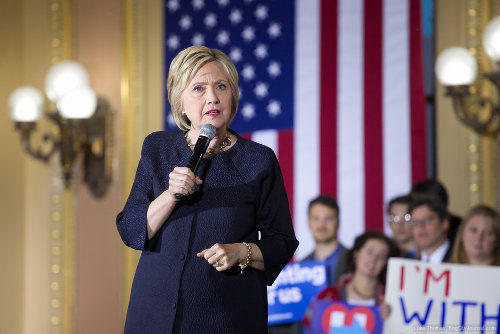
Presumed Democratic nominee for president, Hillary Clinton. File photo by Luke Thomas.
July 23, 2016
The growth in college debt is an issue close to the hearts of millions of voters, but for young Americans who came of age in the midst of the recession, it is a problem of towering proportions. For many of the “Millennial” generation, finding meaningful employment to repay staggering student loan debt, has proved a near impossible challenge.
More than 40 million Americans owe $1.3 trillion in outstanding student loan debt. Even as people have cut back on other types of debt, such as mortgages and car loans – education has remained a priority. Obtaining a college degree has traditionally been viewed as a stepping-stone to upward mobility and greater income, but this logic no longer holds because higher rates of graduation mean there are often more qualified candidates than jobs. Further compounding the problem is the fact that cumulative layers of debt effectively bar Americans from participating in the broader economy and discourages them from starting their own businesses. For Millennials, this means fewer jobs and discouraging employment trends going forward.
Democratic Party nominee Hillary Clinton recently announced her plan for dealing with the problem of student loan debt, unveiling a proposal that will allow most students to attend public colleges at no cost. Many pundits feel this will enhance Clinton’s appeal among young members of the electorate as she battles against Republican Party nominee, Donald Trump.
The affordability of higher education emerged as a major issue in this year’s Democratic Party election politics. Clinton clearly took inspiration from the platform of Senator Bernie Sanders, who advocated for “free” college education for all. There are, of course, significant differences in that Clinton’s proposal for no-cost tuition will not extend to every student in the country. Her “New College Compact”, if enacted, will cover approximately 80 percent of families. Nevertheless, Sanders has praised Clinton’s efforts asaying they represent a fusion of the best ideas from both campaigns. This was a sign of rapprochement between Clinton and Sanders, who had contended vigorously and not always amicably throughout the Democratic primary process.
The most immediate action outlined by the Clinton student loan plan is a three-month moratorium on student loan payments to the federal government. This will – at least in the hypothetical – allow debtors to restructure and refinance their loans to obtain more favorable terms and lower interest rates. It may offer relief to many who will see significant savings because of low current rates. Clinton claims that, if elected, she will unilaterally decree this step be taken via executive powers of the presidency.
A more ambitious part of her program would make tuition at public colleges and universities free for residents of the states in which the institutions are located. While this benefit will be means-tested, the ceiling will be pretty high – starting at a family income of $85,000, which will be increased in stages until it’s at $125,000 by 2021.
Other policy changes promoted by Clinton include building upon current student loan forgiveness programs for those who enter public service and teaching, year-round availability of Pell Grant financing, special incentives for entrepreneurs who found startup companies and the early employees of those firms, and income-based repayment programs. Clinton’s supporters peg the cost of the entire package of measures at around $350 billion over 10 years, but critics contend that the true price tag is likely to be closer to $500 billion. It would be paid for by changes in tax deductions for high-income taxpayers, though criticism has mounted over whether Clinton will be able to cross the Republican aisle and find the funds to carry out her plans to full-scale implementation.
The Clinton camp hopes this plan will sweeten the pot for Millennial voters, a large subset of whom felt revitalized by Sanders’ grander ambitions to transform the nation and move the Democratic party left of center.
When Clinton and Sanders met in Washington, D.C. last month, the two spoke at length on the topic of college affordability and how to ensure it remains at the core of the Democratic Party’s election goals. Clinton’s proposed actions for tackling student debt may marginally improve her standing among young people, though the jury is still out on this conclusion. Although the financial underpinnings of her plan aren’t exactly fully worked out yet, we can expect its general contours to be appealing to those who have taken out student loans, those who intend to go to college in the coming years, and the parents of such students. By combining short-range ideas, like the three-month halt to repayments, with long-term alterations in the system of public higher education, we may hopefully begin to see a winning package of solutions.


 The Hunger Site
The Hunger Site
No Comments
Comments for Taking a Leaf from Bernie’s Book: Clinton’s Student Loan Plan are now closed.